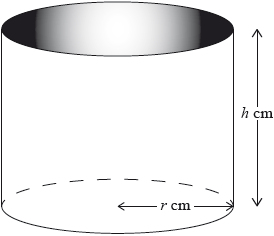| Date | November 2016 | Marks available | 1 | Reference code | 16N.2.SL.TZ0.T_6 |
| Level | Standard Level | Paper | Paper 2 | Time zone | Time zone 0 |
| Command term | Express | Question number | T_6 | Adapted from | N/A |
Question
A water container is made in the shape of a cylinder with internal height cm and internal base radius cm.

The water container has no top. The inner surfaces of the container are to be coated with a water-resistant material.
The volume of the water container is .
The water container is designed so that the area to be coated is minimized.
One can of water-resistant material coats a surface area of .
Write down a formula for , the surface area to be coated.
Express this volume in .
Write down, in terms of and , an equation for the volume of this water container.
Show that .
Find .
Using your answer to part (e), find the value of which minimizes .
Find the value of this minimum area.
Find the least number of cans of water-resistant material that will coat the area in part (g).
Markscheme
* This question is from an exam for a previous syllabus, and may contain minor differences in marking or structure.
(A1)(A1)
Note: Award (A1) for either OR seen. Award (A1) for two correct terms added together.
[2 marks]
(A1)
Notes: Units not required.
[1 mark]
(A1)(ft)
Notes: Award (A1)(ft) for equating to their part (b).
Do not accept unless is explicitly defined as their part (b).
[1 mark]
(A1)(ft)(M1)
Note: Award (A1)(ft) for their seen.
Award (M1) for correctly substituting only into a correct part (a).
Award (A1)(ft)(M1) for rearranging part (c) to and substituting for in expression for .
(AG)
Notes: The conclusion, , must be consistent with their working seen for the (A1) to be awarded.
Accept as equivalent to .
[2 marks]
(A1)(A1)(A1)
Note: Award (A1) for , (A1) for or , (A1) for .
[3 marks]
(M1)
Note: Award (M1) for equating their part (e) to zero.
OR (M1)
Note: Award (M1) for isolating .
OR
sketch of derivative function (M1)
with its zero indicated (M1)
(A1)(ft)(G2)
[3 marks]
(M1)
Note: Award (M1) for correct substitution of their part (f) into the given equation.
(A1)(ft)(G2)
[2 marks]
(M1)
Note: Award (M1) for dividing their part (g) by 2000.
(A1)(ft)
Notes: Follow through from part (g).
14 (cans) (A1)(ft)(G3)
Notes: Final (A1) awarded for rounding up their to the next integer.
[3 marks]

